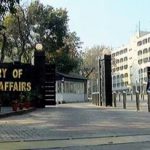By Iftikhar Ahmed
MULTAN, Jun 12 (APP): With our population estimated to crossing 220 million figure, the country would be in dire need of enhancing agricultural production during days ahead to meet domestic needs and enhance export volume to earn foreign exchange.
Since the country has been bifurcated into different provinces and zones, the experts see the crop zoning as vital for getting desired contribution of the agriculture sector in Gross Domestic Product (GDP).
Bestowed with uncountable bounties of nature South Punjab is a fertile region for crops production but the cultivation trend keeps changing due to improper crop zoning mechanism.
There was a time when South Punjab landscape used to amuse the commuters by its white-sea-look (cotton crop) on both sides of roads but over the decades this trend took a dramatic turn with sugarcane replacing the cotton gradually.
“Cotton used to be almost everywhere and in December, the full blossomed cotton flowers used to look like a white sea,” recalled Rabia Sultan, a progressive farmer from Thatha village in Muzaffargarh district.
Ms Sultan used to grow cotton on an area of more than 200 acres but now she has a crop mix of wheat, sugarcane, mango with cotton reduced to just 35-40 acres.
“Whole of South Punjab was a central place in terms of cotton cultivation,” she said and quoted example of another district Vehari where cotton was grown even more than whole of Sindh province in 1980s and 1990s.
Rabia Sultan believed that crop zoning was the best option for the government and policy planners to go after. “Specific crop mix in this region can give best production results for being suitable in terms of weather pattern, land fertility and availability of experienced workforce.”
She explained that sugarcane being a water-intensive crop triggers humidity and needs 25-30 water applications throughout in a yearlong activity. “On the other hand cotton needed dry atmosphere to avoid pest pressure. It is also a mainstay for our textile industry.”
Almost a decade back Pakistan had 7.8 million acres cotton area with major contribution of almost 6.2 million acres from Punjab. But in coming years this area shrunk to almost five million acres with Punjab standing at 3.1 million acres.
“Crop zoning is a beautiful idea and Pakistan will have to opt for it one day. But, we would be needing consent of provinces to implement this mechanism,” said Dr Muhammad Ali Talpur, Advisor to the Ministry of National Food Security and Research.
He said crop zoning would also help us save our vital water resource as well as reduce cost of agricultural inputs. “Area from Punjab’s Sahiwal district to South Punjab and up to lower Sindh’s Sanghar district forms the cotton belt and we need to fully benefit from our fertile land.”
He said that in Sindh province, rice and cotton areas were separated by river Indus with a strip on its right suitable for rice and on the left from Ghotki to Tando Momin Khan including Sukkur, Khairpur, Naushehro Feroze, Nawab Shah, Matiari, Hyderabad, Sanghar and Tando Allah Yar suitable for cotton.
“Crop zoning is in practice in developed countries as it helps governments in proper assessment of the specific crops cultivation for domestic use as well as export requirements,” he said.
Looking otherwise the cultivation process is driven my multiple factors like farmers’ needs, crop cost and its disposal, crop rate and market mechanism as well as specific industrialization in specific areas.
Secretary Agriculture South Punjab Saqib Ali Ateel differs the idea of restricting farmers to a single crop saying, “it might not be a good idea. However, agro-ecological zones with recommendations of a set of crops suitable for respective zones would be enough.”
He opined that an effort to promote and encourage agro-based crops-specific industry in each zone could be vital. “Once this happens, the policy and farmers choice would converge at one point meaning thereby that crops recommended by experts for each zone would become an automatic choice of farmers for their profitability.”
Khawaja Shoaib, another progressive farmer also termed the idea of crop zoning as impracticable saying that profit margin drives farmers’ choice for crops.
“Moreover, farmers need different crops including fodder for their cattle. Then how could they be restricted to one crop,” he questioned. “Whenever, any such policy is devised, it should focus all aspects like domestic needs, profitability, marketing mechanism as well as exports potential.”
In a contrary argument, although Ms Rabia Sultan also admitted farmers’ psychology of choosing crop on the basis of profit potential yet she insisted on crop zoning as a way forward for the country.
“We shall be facing serious food security issues in days to come,” she said citing a recent report from economist magazine that threat of food shortage was looming large on the world as well as Pakistan.
“Even being an agricultural country, we have to import wheat for our local consumption,” she said also mentioning to climate change. “This phenomenon with sudden shift to summer from winter affected our wheat crop reducing the per acre yield.”
She said keeping view the rising population and changing weather patterns, we would have to urgently shift to crop zoning as well as adaptation measures to cope with future challenges. “If we do not formulate policies compatible to changing situations, we would be in serious trouble.”






